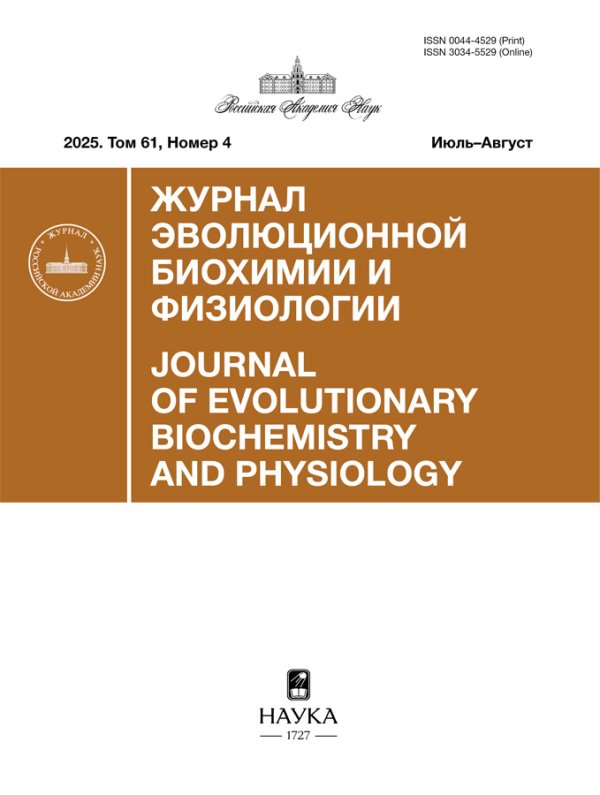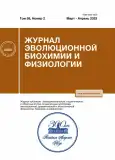ОБЪЕМ ГИППОКАМПА И СПЕКТР НЕЙРОМЕТАБОЛИТОВ У ЗРЕЛЫХ СЕРЫХ КРЫС (RATTUS NORVEGICUS), СЕЛЕКЦИОНИРУЕМЫХ ПО РЕАКЦИИ НА ЧЕЛОВЕКА: ВЛИЯНИЕ РАННЕЙ СОЦИАЛЬНОЙ НЕСТАБИЛЬНОСТИ
- Авторы: Шихевич С.Г.1, Акулов А.Е.1, Кожемякина Р.В.1, Мошкин М.П.1, Гербек Ю.Э.1, Гулевич Р.Г.1
-
Учреждения:
- Институт цитологии и генетики СО РАН
- Выпуск: Том 59, № 2 (2023)
- Страницы: 100-111
- Раздел: ЭКСПЕРИМЕНТАЛЬНЫЕ СТАТЬИ
- URL: https://journals.rcsi.science/0044-4529/article/view/136686
- DOI: https://doi.org/10.31857/S0044452923020055
- EDN: https://elibrary.ru/BINIQT
- ID: 136686
Цитировать
Полный текст
Аннотация
Ранее методом магнитно-резонансной спектроскопии (МРС) было показано, что в дорзальном гиппокампе у самцов крыс, селекционируемых на агрессивное поведение по отношению к человеку, понижено содержание γ-аминомасляной кислоты (ГАМК), N-ацетиласпартата и креатинина совместно с фосфокреатинином, но повышено содержание фосфорилэтаноламина по сравнению с самцами, селекционируемыми на ручное поведение. В данной работе исследовали влияние ранней социальной нестабильности на объем гиппокампа и спектр нейрометаболитов в дорзальном гиппокампе у взрослых агрессивных, ручных и неселекционируемых крыс. Условия социальной нестабильности состояли из более раннего отьема от матери, содержания самцов одного и того же поведения в парах до 3-х месячного возраста и ежедневной замены соседей по клетке с 19-го по 25-й день жизни. В контрольной группе крысят отнимали от матерей на 30 день, они содержались по 4–5 самцов в клетке до 3 мес. Показано, что у агрессивных крыс как абсолютный, так относительный объем гиппокампа был меньше, чем у ручных, тогда как условия социальной нестабильности не влияли на этот параметр. В экспериментальной группе только у агрессивных крыс отмечали понижение содержания фосфорилэтаноламина и повышение аланина в дорзальном гиппокампе по сравнению с контрольными животными, что может быть связано с понижением стресс-реакции у этих животных, которое наблюдали ранее. Из полученных результатов следует, что агрессивные крысы более чувствительны к условиям социальной нестабильности. Кроме того, условия ранней нестабильности и отбор на агрессивное поведение оказывали разнонаправленное влияние как на метаболизм фосфорилэтаноламина, так и на интегральные характеристики метаболического профиля в дорзальном гиппокампе.
Ключевые слова
Об авторах
С. Г. Шихевич
Институт цитологии и генетики СО РАН
Email: gulevich@bionet.nsc.ru
Россия, Новосибирск
А. Е. Акулов
Институт цитологии и генетики СО РАН
Email: gulevich@bionet.nsc.ru
Россия, Новосибирск
Р. В. Кожемякина
Институт цитологии и генетики СО РАН
Email: gulevich@bionet.nsc.ru
Россия, Новосибирск
М. П. Мошкин
Институт цитологии и генетики СО РАН
Email: gulevich@bionet.nsc.ru
Россия, Новосибирск
Ю. Э. Гербек
Институт цитологии и генетики СО РАН
Email: gulevich@bionet.nsc.ru
Россия, Новосибирск
Р. Г. Гулевич
Институт цитологии и генетики СО РАН
Автор, ответственный за переписку.
Email: gulevich@bionet.nsc.ru
Россия, Новосибирск
Список литературы
- Yang Y, Glenn AL, Raine A, Phil D (2008). Brain abnormalities in antisocial individuals: implications for the law. Behav Sci Law 26: 65–83. https://doi.org/10.1002/bsl.788
- Kohl C, Riccio O, Grosse J, Zanoletti O, Fournier C, Schmidt MV, Sandi C (2013) Hippocampal neuroligin-2 overexpression leads to reduced aggression and inhibited novelty reactivity in rats. PNAS 8 (2): e56871. https://doi.org/10.1371/journal.pone.005687
- Zetzsche T, Preuss U, Frodl T, Schmitt G, Seifert D, Munchhausen E, Tabrizi S, Leinsinger G (2007) Hippocampal volume reduction and history of aggressive behaviour in patients with borderline personality disorder. Psychiatry Res: Neuroimaging 154: 157–170. https://doi.org/10.1016/j.pscychresns.2006.05.010
- Ruocco AC, Amirthavasagam S, Zakzanis KK (2012) Amygdala and hippocampal volume reductions as candidate endophenotypes for borderline personality disorder: A meta-analysis of magnetic resonance imaging studies. Psychiatry Res: Neuroimaging 201: 245–252. https://doi.org/10.1016/j.pscychresns.2012.02.012
- Bremner JD, Randal P, Vermetten E, Staib L, Bronen RA, Mazure C, Capelli S, McCarthy G, Innis RB, Charney DS (1997) Magnetic resonance imaging-based measurement of hippocampal volume in posttraumatic stress disorder related to childhood physical and sexual abuse–a preliminary report. Biol Psychiatry 41: 23–32. https://doi.org/10.1016/S0006-3223(96)00162-X
- Woon FL, Sood S, Hedges DW (2010) Hippocampal volume deficits associated with exposure to psychological trauma and posttraumatic stress disorder in adults: A meta-analysis. Prog Neuropsychopharmacol Biol Psychiatry 34: 1181–1188. https://doi.org/10.1016/j.pnpbp.2010.06.016
- Kalisch R, Schubert M, Jacob W, Kesler M, Hemauer R, Wigger A, Landgraf R, Auer DP (2006) Anxiety and hippocampus volume in the rat. Neuropsychopharmacology 31: 925–932. https://doi.org/10.1038/sj.npp.1300910
- Veenema AH, Neumann ID (2007) Neurobiological mechanisms of aggression and stress coping: a comparative study in mouse and rat selection lines. Brain Behav Evol 70 (4): 274–285. https://doi.org/10.1159/000105491
- Welniak–Kaminska M, Fiedorowicz M, Orzel J, Bogorodzki P, Modlinska K, Stryjek R, Chrzanowska A, Pisula W, Grieb P (2019) Volumes of brain structures in captive wildtype and laboratory rats: 7T magnetic resonance in vivo automatic atlas-based study. PLoS One 14 (4): e0215348. https://doi.org/10.1371/journal.pone.0215348
- Eiland L, Romeo RD (2013) Stress and the developing adolescent brain. Neuroscience 249: 162–171. https://doi.org/10.1016/j.neuroscience.2012.10.048
- Vythilingam M, Heim C, Newport J, Mille, A, Anderson E, Bronen R, Brummer M, Staib L, Vermetten E, Charney DS, Nemeroff CB, Bremner JD (2002) Childhood Trauma Associated With Smaller Hippocampal Volume in Women With Major Depression. Am J Psychiatry 159: 2072–2080. https://doi.org/10.1176/appi.ajp.159.12.2072
- Jackowski A, Perera TD, Abdallah CG, Garrido G, Tang CY, Martinez J, Mathew SJ, Gorman JM (2011) Early-life stress, corpus callosum development, hippocampal volumetrics, and anxious behavior in male nonhuman primates. Psychiatry Res: Neuroimaging 192: 37–144. https://doi.org/10.1016/j.pscychresns.2010.11.006
- Coplan JD, Mathew SJ, Abdallah CG, Mao X, Kral JG, Smith ELP, Rosenblum LA, Perera TD, Dwork AJ, Hof PR, Gorman JM, Shungu DC (2010) Early-life stress and neurometabolites of the hippocampus. Brain Res 1358: 191–199. https://doi.org/10.1016/j.brainres.2010.08.02
- Veenema AH (2009) Early life stress, the development of aggression and neuroendocrine and neurobiological correlates: what can we learn from animal models? Front Neuroendocrinol 30: 497–518. https://doi.org/10.1016/j.yfrne.2009.03.003
- Oskina I, Herbeck Y, Shikhevich S, Plyusnina I, Gule-vich R (2008) Changes in the hypothalamic–pituitary–adrenal axis and the immune system in animals selected for domestic behavior. The Herald of Vavilov Society for Geneticists and Breeding Scientists 12: 39–49.
- Plyusnina I, Solov’eva M (2010) Intraspecific intermale aggression in tame and aggressive Norway rats. Zhurn Vyssh Nervn Deiat Im IP Pavlova 60: 175–183.
- Plyusnina IZ, Solov’eva MY, Oskina IN (2011) Effect of domestication on aggression in gray rats. Behav Genet 41: 583–592. https://doi.org/10.1007/s10519-010-9429-y
- Gulevich RG, Akulov AE, Shikhevich SG, Kozhemyakina RV (2016) Proton-magnetic resonance spectroscopy of neurometabolites in the hippocampi of aggressive and tame male rats. Rus J Genetics: Applied Res 6: 430–436. https://doi.org/10.1134/S2079059716040079
- Gulevich RG, Shikhevich SG, Konoshenko MY, Kozhemyakina RV, Herbeck YuE, Prasolova LA, Oskina IN, Plyusnina IZ (2015) The influence of social environment in early life on the behavior, stress response, and reproductive system of adult male Norway rats selected for different attitudes to humans. Physiol Behav 144: 116–123. https://doi.org/10.1016/j.physbeh.2015.03.018
- McCormick CM, Green MR, Cameron NM, Nixon F, Levy MJ, Clark RA (2013) Deficits in male sexual behavior in adulthood after social instability stress in adolescence in rats. Horm Behav 63: 5–12. https://doi.org/10.1016/j.yhbeh.2012.11
- Sachser N, Kaiser S, Hennessy MB (2013) Behavioural profiles are shaped by social experience: when, how and why. Philos Trans R Soc Lond B Biol Sci 368 (1618): 20120344. https://doi.org/10.1098/rstb.2012.0344
- Moshkin MP, Akulov AE, Petrovski DV, Saik OV, Petrovskiy ED, Savelov AA, Koptyug IV (2014) Proton magnetic resonance spectroscopy of brain metabolic shifts induced by acute administration of 2-deoxy-D- glucose and lipopolysaccharides. NMR Biomed 27: 399–405. https://doi.org/10.1002/nbm.3074
- Albert FW, Schepina O, Winter C, Rompler H, Teupser D, Palme R, Ceglarek U, Kratzsch J et al. (2008) Phenotypic differences in behavior, physiology and neurochemistry between rats selected for tameness and for defensive aggression towards human. Horm Behav 53: 413–421. https://doi.org/10.1016/j.yhbeh.2007.11.010
- Kruska DC (2005) On the evolutionary significance of encephalization in some eutherian mammals: effects of adaptive radiation, domestication, and feralization. Brain Behav Evol 65 (2): 73–108. https://doi.org/10.1159/000082979
- Castellanos FX, Giedd JN, Marsh WL, Hamburger SD, Vaituzis AC, Dickstein DP, Sarfatti SE, Vauss YC, Snell JW, Lange N, Kaysen D, Krain AL, Ritchie GF, Jagath C, Rajapakse JC, Rapoport JL (1996) Quantitative Brain Magnetic Resonance Imaging in Attention-Deficit Hyperactivity Disorder. Arch Gen Psychiatry 53: 607–616. https://doi.org/10.1001/archpsyc.1996.01830070053009
- Hasegawa M, Kida I, Wada H (2010) A volumetric analysis of the brain and hippocampus of rats rendered perinatal hypothyroid. Neurosci Lett 479: 240–244. https://doi.org/10.1016/j.neulet.2010.05.070
- Balazs R, Brooksbank BWL, Davison AN, Eayrs JT, Wilson DA (1969) The effect of neonatal thyroidectomy on myelination in the rat brain. Brain Res 15: 219–232. https://doi.org/10.1016/0006-8993(69)90321-7
- Plyusnina IZ, Shchepina OA, Os’kina IN, Trut LN (2008) Some features of learning in the Morris water test in rats selected for responses to humans. Neurosci Behav Physiol 38: 511–516.
- Luo Y, Cao Z, Wang D, Wu L, Li Y, Sun W, Zhu Y (2014) Dynamic study of the hippocampal volume by structural MRI in a rat model of depression. Neurol Sci 35: 1777–1783. https://doi.org/10.1007/s10072-014-1837-y
- Jenks KR, Lucas MM, Duffy BA, Robbins AA, Gimi B, Barry JM, Scott RC (2013) Enrichment and Training Improve Cognition in Rats with Cortical Malformations. PLoS One 8 (12): e84492. https://doi.org/10.1371/journal.pone.0084492
- Wennstrom M, Hellsten J, Ekstrand J, Lindgren H, Tingstrom A (2006) Corticosterone-Induced Inhibition of Gliogenesis in Rat Hippocampus is Counteracted by Electroconvulsive Seizures. Biol Psychiatry 59: 178–186. https://doi.org/10.1016/j.biopsych.2005.08.032
- Czéh B, Lucassen PJ (2007) What causes the hippocampal volume decrease in depression? Eur Arc. Psychiatry Clin Neurosci 257: 250–260. https://doi.org/10.1007/s00406-007-0728-0
- Xie L, Kang H, Xu Q, Chen MJ, Liao Y, Thiyagarajan M, O’Donnell J, Christensen DJ, Nicholson C, Iliff JJ, Takano T, Deane R, Nedergaard M (2013) Sleep drives metabolite clearance from the adult brain. Science 342: 373–377. https://doi.org/10.1126/science.1241224
- Ilchibaeva TV, Kondaurova EM, Tsybko AS, Kozhemyakina RV, Popova NK, Naumenko VS (2015) Brain-derived neurotrophic factor (BDNF) and its precursor (proBDNF) in genetically defined fear-induced aggression. Behav Brain Res 290: 45–50. https://doi.org/10.1016/j.bbr.2015.04.041
- Riedemann T, Patchev AV, Cho K, Almeida OF (2010) Corticosteroids: way upstream. Mol Brain 3: 2. https://doi.org/10.1186/1756-6606-3-2
- Warner-Schmidt JL, Duman RS (2006) Hippocampal neurogenesis: Opposing effects of stress and antidepressant treatment. Hippocampus 16: 239–249. https://doi.org/10.1002/hipo.20156
- Madhavarao CN, Arun P, Moffet JR, Szucs S, Surendran S, Matalon R, Garbern J, Hristova D, Johnson A, Jiang W, Namboodiri MAA (2005) Defective N-acetylaspartate catabolism reduces brain acetate levels and myelin lipid synthesis in Canavan’s disease. PNAS 102: 5221–5226. https://doi.org/10.1073/pnas.0409184102
- Myller AT, Karhe JJ, Pakkanen TT (2010) Preparation of aminofunctionalized TiO2 surfaces by binding of organophosphates. Appl Surface Sci 257: 1616–1622. https://doi.org/10.1016/j.apsusc.2010.08.109
- Modica-Napolitano JS, Renshaw PF (2004) Ethanolamine and phosphoethanolamine inhibit mitochondrial function in vitro: implications for mitochondrial dysfunction hypothesis in depression and bipolar disorder. Biol Psychiatry 55: 273–277. https://doi.org/10.1016/S0006-3223(03)00784-4
- Llorento R, Villa P, Marco EM, Viveros MP (2012) Analyzing the effects of a single episode of neonatal maternal deprivation on metabolite profiles in rat brain: a proton nuclear magnetic resonance spectroscopy study. Neuroscience 201: 12–19. https://doi.org/10.1016/j.neuroscience.2011
- Zwingmann C, Richter-Landsberg C, Brand A, Leibfritz D (2000) NMR spectroscopic study on the metabolic fate of [3-(13)C]alanine in astrocytes, neurons, and cocultures: implications for glia-neuron interactions in neurotransmitter metabolism. Glia 32 (3): 286–303. https://doi.org/10.1002/1098-1136(200012)32:3<286::aid-glia80>3.0.co;2-p
- Kim-Cohen J, Turkewitz R (2012) Resilience and measured gene-environment interactions. Dev Psychopathol 24 (4): 1297–1306. https://doi.org/10.1017/S095457941200071
Дополнительные файлы















